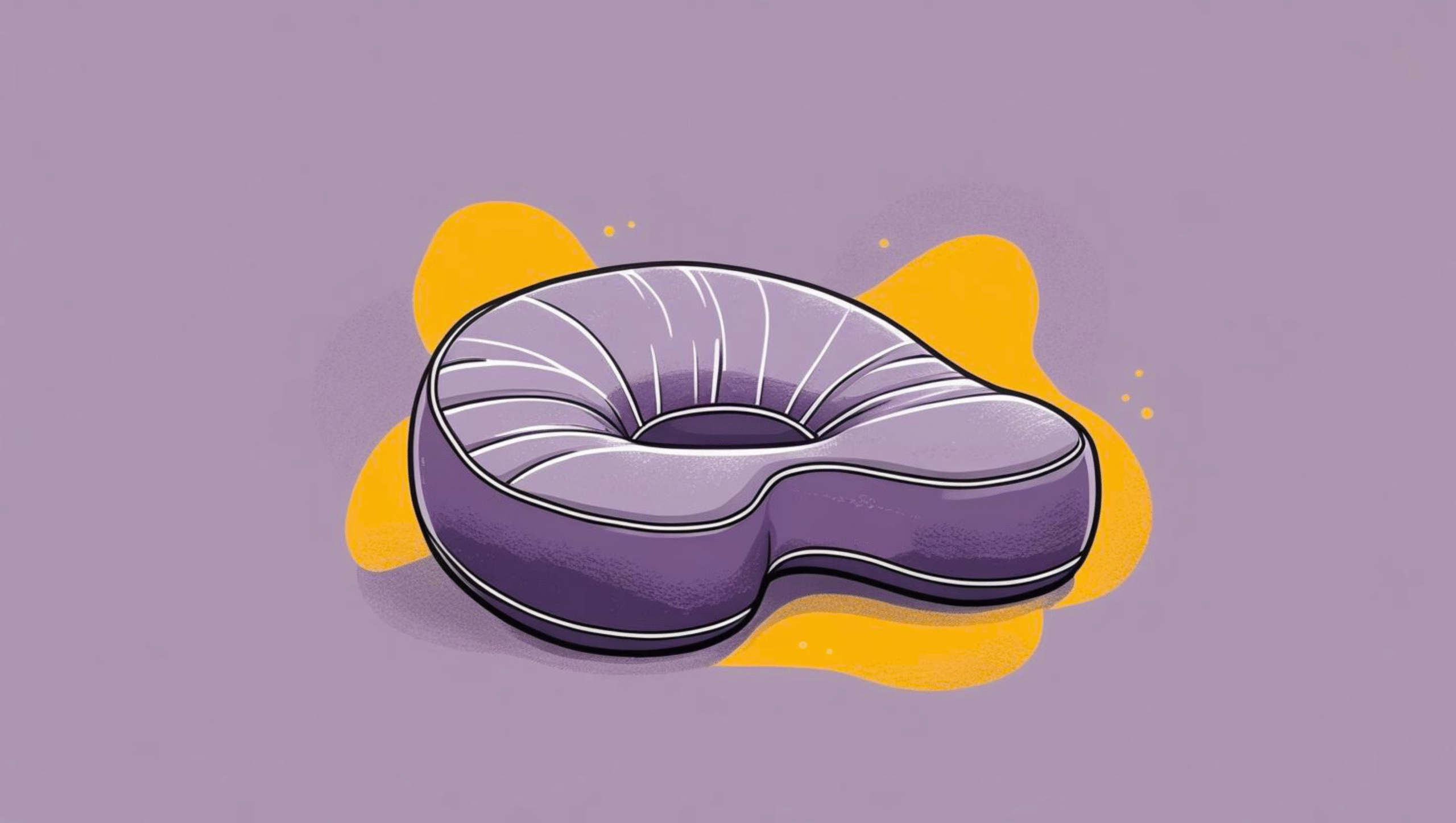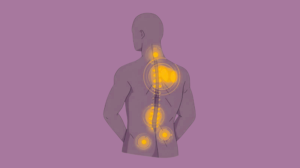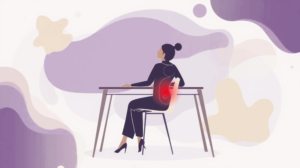If you have experienced a sharp, throbbing sensation in your tailbone after being seated for too long, you are not imagining it. Responding to the demands of modern life – working from home, long hours in the office, and/or marathon car rides, has left many people unable to escape their seats. It can be useful to know that the pressure exerted over an extended period of time on your tailbone (more commonly referred to as your coccyx) can result in discomfort, inflammation, or a longer-term injury like coccydynia.
It may be easy to take a seat for granted, but how we actually sit is important. Sitting can lead to poor posture, uneven pressure distribution, or sitting on a hard, flat surface, all of which can lead to stress on your spinal base. Over time, the tension on the spinal base may radiate to your hips, back, or calves (the lower back is after all, sometimes referred to as the “sacral base”). What do you do if your lower spine is complaining before you even sit?
One obvious solution could surprisingly be very simple: a coccyx cushion. Coccyx cushions are a type of seat cushion which are designed to relieve the pressure that is placed on your tailbone (coccyx) by actually suspending it above the seat surface. So what do they really do? What is a coccyx cushion, and how does it work?
Let’s look at what coccyx cushions are and how they will aid you in making sitting a much more enjoyable part of your day!
What Is a Coccyx Cushion?
A coccyx cushion, sometimes referred to as a tailbone cushion or orthopedic seat cushion, is designed to ease pressure on the tailbone while sitting. Most coccyx cushions have a unique U- or V-shaped cutout at the back of the cushion, which holds the coccyx and creates a void so that the coccyx can’t make direct contact with the sitting surface. Many coccyx cushions are portable and can be used on office chairs, car seats, and airplane seats.
Types of Coccyx Cushions Available
Memory Foam Coccyx Cushions
These are the most popular options and are often associated with a high level of comfort and support. Memory foam contours specifically to your body shape and distributes your weight evenly, which reduces pressure points. This individualized support helps ease pain by reducing the amount of direct stress placed on your tailbone. A study published in the Journal of Physical Therapy Science found that memory foam cushions lowered pressure on the buttocks and improved sitting postures among office workers [1]. Given their solid form, memory foam should hold their shape overtime, as long as they are not compressed too much in the situation of several hours continuous use.
Gel-Based Cushions
Coccyx cushions with gel coating use a layer of cooling gel above supportive foam that work to regulate temperature, thus minimizing heat build-up or sweating in order to stay cool while sitting for a longer time. Based on the layering of gel above the foam, the coccyx cushion will have a slightly firmer surface which some prefer to simply using a gel cushion or memory foam cushion in terms of supportive feel. Coccyx cushions with gel coating are recommended when the user has a warm butt or looking for added pressure relief when wanting enhanced cooling comfort. The gel is designed to dissipate your body weight more evenly when sitting thereby reducing localized loading and pressure which tend to cause discomfort or pain.
Inflatable Travel Cushions
Even an inflatable coccyx cushion can easily be deflated and rolled up because they are made from very lightweight flexible materials like PVC or TPU. While they do not have the same reliable support as a memory foam cushion, they are still useful for infrequent use (as in travel, long car rides, flights, etc.). The inflatable gives users flexibility with their comfort because they can just pump it up to whatever level they like. The cushions are compact so they can easily pack into a backpack or carry-on. This makes an inflatable coccyx cushion a viable option for the users to support their tailbone while on the go.
Why Is the Coccyx Important in Sitting Posture?
The coccyx is an attachment site for muscles, tendons and ligaments. When seated, it is good to understand the coccyx is under pressure, and also when sitting on hard surfaces. If someone has poor posture or prolonged sitting, this can compress the coccyx into an unobtainable position resulting in pain/painful sensations or inflammation. Long term this may develop into coccyx pain (coccydynia) where minor movements, such as getting out of a chair can result in pain.
How Does a Coccyx Cushion Work?
The main purpose of a coccyx cushion is to take pressure off the tailbone. When you use the cushion, it allows the coccyx to “float”, effectively relieving direct pressure. The removal of pressure on the coccyx can also decrease or eliminate inflammatory, bruising, and nerve irritation related to direct pressure on the coccyx. Researchers published a study in the Spine Journal that found cushions could decrease localized pain in patients with chronic coccydynia [2].
Posture Correction and Spinal Alignment
Coccyx cushions maintain the body’s natural posture. They encourage you to sit in a neutral posture with your pelvis rather than slouched, which can help to ease lumbar spine, shoulder, and neck tension. Our posture can have a positive ripple effect on the rest of our spine and musculature. The National Institutes of Health (NIH) has research demonstrating that spinal alignment can reduce stress to spinal discs and muscles related to alignment [3].
Comfort for Long Sitting Hours
Discomfort not only detracts you; it also wears you down physically and mentally. A well-designed coccyx cushion produces comfort by equally distributing your weight and supporting related sensitive regions. It also absorbs vibrations while driving or typing, so it is a very versatile option for professionals or travelers. In a study conducted in Occupational Medicine, ergonomic seat cushions were found to improve work productivity and significantly decreased perceived workload during longer work periods [4].
Who Can Benefit from a Coccyx Cushion?
1. Office Workers and Remote Professionals
If you are in front of the screen for hours, you may develop issues relating to posture, and also sores from pressure. A coccyx cushion can relieve some of the impacts from being sedentary, by promoting better posture and making you less likely to have prolonged pressure on your tailbone.
2. Drivers and Frequent Travelers
Regardless of whether you are driving for multiple hours, or you are simply a frequent flyer, the vibration and sheer pressure of prolonged sitting take a toll on your tailbone. However, truck drivers, delivery people, and frequent flyers, all have reported increases in comfort and less pain after they started using their coccyx cushion.
3. People with Tailbone Injuries or Surgery Recovery
A fall or trauma to the tailbone can result in chronic pain, often made worse when sitting. Coccyx cushions are a non-invasive means to address this discomfort while recovering. Coccyx cushions can be recommended by surgeons and physical therapists in the postoperative phase [5].
4. Seniors with Lower Back Discomfort
Our spinal discs become less elastic and less cushioning as we age, which leads to more stress and pain in the lower back. Older adults with arthritis, degenerative disc disease, or just general discomfort are often helped using coccyx cushions.
5. Pregnant Women or Postpartum Recovery
Pregnancy can change the position of the pelvis and add pressure to the lower spine and coccyx. Many women will experience pain at the coccyx (also called tailbone) post partum due to trauma sustained during childbirth. A coccyx cushion balances the gentle and direct relief during this sensitive time.
What Are the Benefits of Using a Coccyx Cushion?
- Alleviates pressure on the tailbone and lower spine
- Promotes better sitting posture
- Reduces discomfort from sciatica and herniated discs
- Improves comfort during long periods of sitting
- Helps with postpartum and post-injury recovery
- Enhances focus and productivity at work
- Prevents slouching and muscle strain
- Supports elderly individuals with chronic back discomfort
- Offers a non-invasive pain management solution
How to Choose the Right Coccyx Cushion?
- Identify Your Needs: Are you dealing with injury, pregnancy-related pain, or general discomfort? The reason for use helps narrow your choices.
- Check the Material: Memory foam is ideal for personalized support. Gel-infused cushions offer cooling comfort. Choose one that suits your climate and sensitivity level.
- Size and Shape: Make sure it fits your chair and body type. Oversized or undersized cushions can affect alignment and reduce benefits.
- Cover Quality: Look for a removable, breathable, and washable cover for easy maintenance.
- Portability: If you plan to use the cushion in multiple locations, consider one with a handle or carrying case.
- Non-Slip Base: A cushion that slides off your seat can be a safety risk and inconvenient.
- Reviews and Certifications: Look for cushions recommended by physical therapists or tested in clinical settings.
Tips for Using a Coccyx Cushion Effectively
Proper Placement on Chair or Seat
Place the cushion with the cutout toward the back of your seat, so your tailbone is suspended. Your hips should be slightly higher than your knees, promoting a natural curve in your lower spine.
Cleaning and Maintenance
Always select a cushion with covering that can be removed and washed with a machine. Regularly clean the inner foam with either a vacuum or simply air dry. Unless it is specifically mentioned by the manufacturer, do not make the foam wet.
When to Consult a Doctor
A coccyx cushion might provide you some relief but isn’t meant to be used instead of medical professional advice. You should reach out to a doctor or orthopedic physician should you have numbness, continuous pain or worsening symptoms . They may want to perform imaging tests or physical therapy to go along with an ergonomic set up.
Conclusion
If sitting has become an experience you dread instead of enjoying, it’s time to consider purchasing a coccyx cushion. People from many different professions – office worker, new mothers, drivers, seniors – can benefit from a simple yet very effective cushion to help relieve pressure on the tailbone, provide posture assistance, and assist in essentially feeling significantly more comfortable. While they are small, their benefits are quite large. If you have the right cushion, long hours of sitting does not result in lasting pain.
Frequently Asked Questions:
1. Can I use a coccyx cushion for sciatica?
Yes. Coccyx cushions relieve pressure on the lower spine and may help reduce nerve pain related to sciatica. However, consult a healthcare provider for a comprehensive treatment plan [6].
2. Are coccyx cushions recommended after surgery?
Yes, especially after lower spinal or tailbone surgery. They help reduce pressure and prevent inflammation. Always follow your doctor’s advice.
3. How do I clean and maintain my coccyx cushion?
Most come with washable covers. The inner cushion can often be cleaned with a vacuum or spot-treated, depending on material.
4. Do coccyx cushions really work for back pain?
Studies support their effectiveness in reducing pressure-related pain, particularly in the tailbone and lumbar regions [1][2][4].
5. How long should I sit on a coccyx cushion per day?
There’s no strict limit, but it’s best to take breaks every 30–60 minutes. Using the cushion consistently helps manage pain over time.
References
1. https://www.jstage.jst.go.jp/article/jpts/27/6/27_jpts-2015-122/_pdf
2. https://www.spine.org/Research-Clinical-Care/Clinical-Guidelines
3. https://www.ncbi.nlm.nih.gov/pmc/articles/PMC1050574/
4. https://academic.oup.com/occmed/article/63/2/121/1406612























